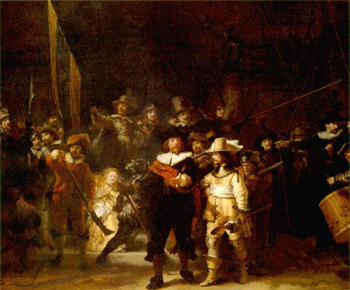
Night Watchalso known as The company of Frans Banning Cock preparing to march out

|
Rembrandt's The Night Watch is a group portrait, a common type of painting in his day. In particular, it is a group portrait of a militia, a popular commission, particularly in his native Netherlands. Although it follows many conventions of the group portraiture of the day, Rembrandt, true to form, simultaneously overhauled many traditional aspects of the style.
Rembrandt painted the group with much of their important equipment present. Flags, snare drums, swords, muskets, partisans, and pikes are all clearly visible. He also painted them in a moment of relative action, with uniforms appropriate to the occasion. The piece does not appear to be that of a group of men in a contrived, studied pose. These were the standards of the day, and Rembrandt followed them dutifully.
It is in the finer details that Rembrandt's breaking of the rules becomes more readily apparent. Quite often, group portraits of this type arranged its subjects on a single plane, in symmetrical or parallel lines, all at roughly the same height. Rembrandt broke sharply from this standard, constructing a far more dynamic group arrangement. In The Night Watch, there is a central group, moving forward in double file towards the viewer. Lateral groups are subordinated to this one. The result is a feeling of bustling activity, with several groups acting seemingly independently, but, with each subordinated to the central group, overall unity is maintained.
Rembrandt also did not distribute light evenly throughout the painting; it is as if it is not actual sunlight. Light such as this was more typically used in religious scenes because of its otherworldly quality. Its use here is very unconventional. Also, figures and objects within the painting are defined by broad brushstrokes, the paint thickly applied--almost the antithesis of the prevailing careful delineation of the day.
An oft-overlooked curio of this painting is that Rembrandt painted himself into it. Between the man holding the flag aloft and the man to his immediate right, the top half of the artist's head is visible, poking up from behind their shoulders.












